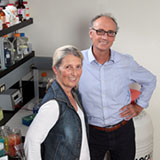


Posted October 7, 2015
Donato Romagnolo, Ph.D., MSc., Ornella Selmin, Ph.D., University of Arizona Cancer Center
 While genetic mutations in the BRCA1 gene are well-characterized in breast cancer, it is less understood why a significant proportion of individuals with breast cancer have reduced BRCA1 expression despite the presence of intact BRCA1 alleles. Epigenetic changes, such as histone and DNA modifications, can modulate gene expression without disrupting the underlying genetic sequence. Furthermore, these signatures can be altered through exposure to a variety of dietary and environmental factors. CpG hypermethylation, an epigenetic modification that leads to gene silencing, of the BRCA1 promoter has been linked to decreased BRCA1 protein levels and the development of high-grade breast carcinomas. Critical stages of mammary gland development occur in utero. Thus, prenatal exposure to environmental factors that alter the BRCA1 epigenetic landscape could result in increased breast cancer susceptibility. This idea was explored by Dr. Donato Romagnolo in work funded by two BRCP grants, an FY09 Idea Award and an FY13 Idea Expansion Award.
While genetic mutations in the BRCA1 gene are well-characterized in breast cancer, it is less understood why a significant proportion of individuals with breast cancer have reduced BRCA1 expression despite the presence of intact BRCA1 alleles. Epigenetic changes, such as histone and DNA modifications, can modulate gene expression without disrupting the underlying genetic sequence. Furthermore, these signatures can be altered through exposure to a variety of dietary and environmental factors. CpG hypermethylation, an epigenetic modification that leads to gene silencing, of the BRCA1 promoter has been linked to decreased BRCA1 protein levels and the development of high-grade breast carcinomas. Critical stages of mammary gland development occur in utero. Thus, prenatal exposure to environmental factors that alter the BRCA1 epigenetic landscape could result in increased breast cancer susceptibility. This idea was explored by Dr. Donato Romagnolo in work funded by two BRCP grants, an FY09 Idea Award and an FY13 Idea Expansion Award.
Ligands that bind to and activate the aromatic hydrocarbon receptor (AhR), such as 2,3,7,8-Tetrachlorodibenzodioxin (TCDD), are present in the environment and in certain foods. Dr. Romagnolo demonstrated that exposure to TCDD enhances AhR occupancy and CpG island hypermethylation at the BRCA1 promoter in breast cancer cells, resulting in decreased BRCA1 protein expression. The effect of prenatal exposure to TCDD was examined using an animal model, wherein TCDD exposure in utero resulted in reduced mammary gland differentiation and BRCA1 expression in female offspring. As observed in breast cancer cells in vitro, reduced BRCA1 expression was mediated by increased DNA methyltransferase-1 (DNMT1) recruitment and subsequent CpG hypermethylation at the BRCA1 promoter in mammary tissue. These findings indicate that prenatal exposure to compounds that activate the AhR and alter the epigenetic state of the BRCA1 promoter could be a potential breast cancer risk factor in female offspring, suggesting that pregnant women should avoid exposure to such agents. The potential implications of these studies, however, extend beyond exposure to agents such as TCDD since other factors that are ubiquitous in the environment can modulate the AhR. These include photoproducts of UV light and certain metabolites of dietary compounds.
Reversal or prevention of harmful epigenetic modifications at the BRCA1 promoter could be valuable in preventing sporadic breast cancer. Resveratrol, a natural compound found in a variety of foods, is known to block AhR activation and therefore could protect against the silencing of BRCA1 by TCDD or other AhR-stimulating compounds. In an animal model, pre-exposure to resveratrol stimulated expression of the AhR repressor and its recruitment to the BRCA1 gene, preventing the harmful effects of TCDD in the mammary tissue of female offspring. These results provide evidence to suggest that pregnant mothers could decrease their female offspring's susceptibility for sporadic breast cancer through diets containing agonists of the AhR, like resveratrol.
To further build on these exciting findings, Dr. Romagnolo has recently been awarded an FY14 Breakthrough Level 2 Award providing an opportunity to investigate the impact of in utero exposure to genistein, a dietary soy isoflavone and known DNMT inhibitor, on BRCA1 promoter hypermethylation, gene expression, and the development of triple negative breast cancer in female offspring. If successful, these results could identify an additional maternal dietary factor that may have preventative effects on breast cancer in offspring. Dr. Romagnolo shares a laboratory at the University of Arizona Cancer Center with Dr. Ornella Selmin, who was a coauthor on the cell culture and animal studies that investigated the epigenetic changes on the BRCA-1 gene associated with activation of the AhR. Dr. Selmin is also a co-investigator on the FY14 Breakthrough Level 2 Award.














